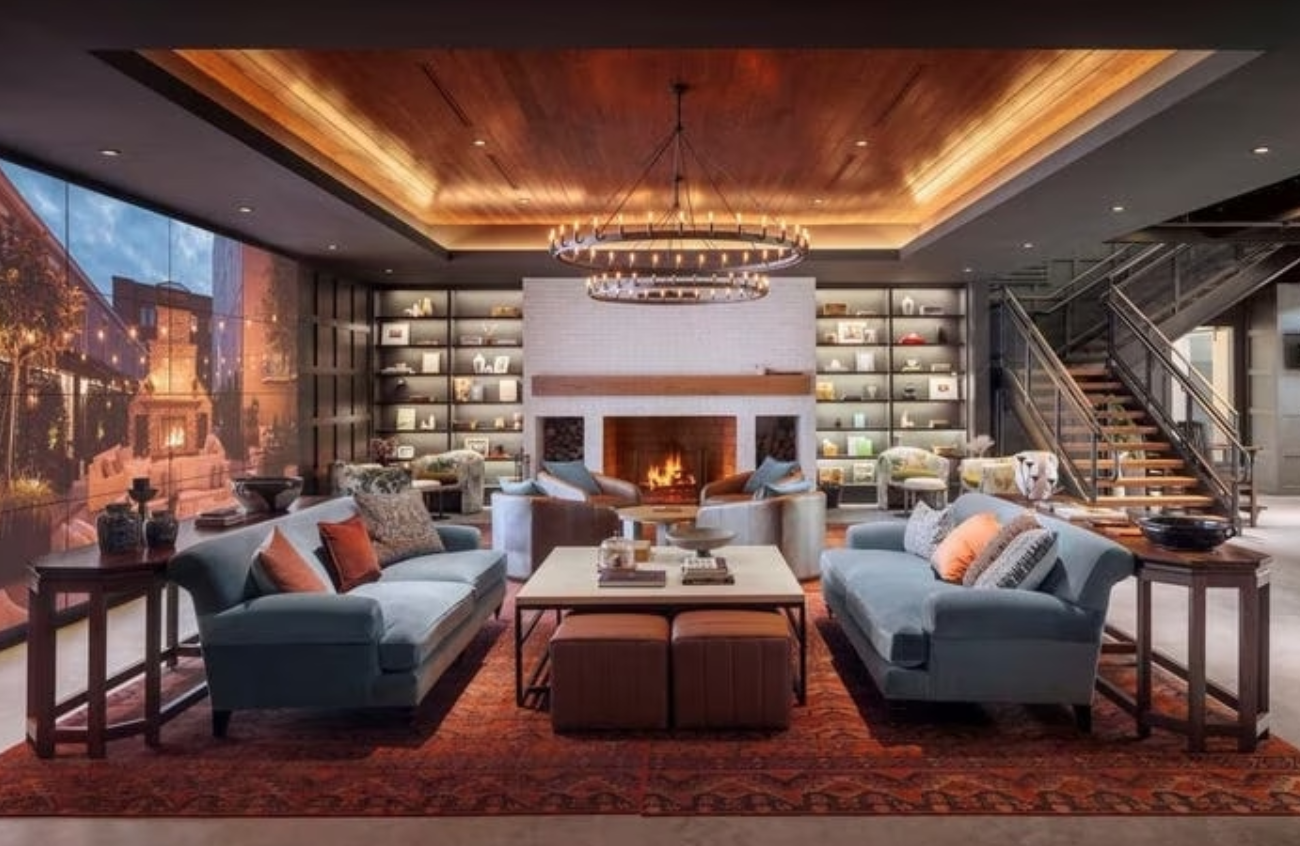
When you walk into the 30,000-square-foot space that constitutes Rockbridge’s new headquarters in Columbus, Ohio, there’s a good chance you won’t realize you’re in a private hospitality investment firm.
The entrance resembles a high-end restaurant or hotel, designed to be a beacon of the company’s culture. High ceilings, dim lighting, potted botanicals lining the entrance and a neon “Welcome to Rockbridge” sign set the tone for the rest of the space. Other areas, including one with a brick fireplace donning inserts for freshly cut wood, bookcases and barrel chairs arranged in a circle perfect for spurring conversation all seem to say, “this is your space.” It’s built for collaboration.
The entrance resembles a high-end restaurant or hotel, designed to be a beacon of the company’s culture. High ceilings, dim lighting, potted botanicals lining the entrance and a neon “Welcome to Rockbridge” sign set the tone for the rest of the space. Other areas, including one with a brick fireplace donning inserts for freshly cut wood, bookcases and barrel chairs arranged in a circle perfect for spurring conversation all seem to say, “this is your space.” It’s built for collaboration.
But the risk has paid off, he says. “Our team feels at home and brings their families here to see our office, and the next generation of team members want to be here.”
Hospitality and the Future of Office Work
While there may not be a single “answer” to turn the commercial office industry around, Merkel said one potential solution could be companies and office investors looking to the hospitality industry.
“One of the great things about hospitality is it has always had to be consumer focused. You’re serving needs, but it’s also a consumer product that people get to choose daily,” Merkel says. “As a result, hospitality is a business model that has stayed on the cutting edge and has continued to evolve and stay relevant.”
Merkel’s thriving in-office culture is a stark contrast to what many other entrepreneurs are experiencing. Headlines in top business magazines, newspapers and online articles highlight the struggling commercial office sector, pointing the blame at employee desires to remain working remotely.
That’s putting it lightly.
“Property investment has plummeted. Leasing activity has dropped. Delinquencies have surged, and maturing mortgage loans face starkly higher refinancing rates. Large global firms plan to reduce office space as the trend toward remote work that accelerated during the pandemic persists,” Investopedia said, noting in the article’s headline that “Warning signals in U.S. commercial office markets haven’t stopped flashing.”

Public space within Rockbridge’s headquarters.
Adapting to meet consumer needs has not been a part of the commercial office model. While the business world has changed, the office model hasn’t yet needed to evolve to keep up. Those days are over, as the ways in which business was conducted 20 years ago are no longer relevant today. Generational changes from Boomers to Gen X, Millennials, and Gen Z means each think and behave differently, and this is true of the commercial office model. The needs and desires of companies and team members have changed.
“It is important to evolve and invest in all real estate types to continue to be relevant with what the consumer is looking for today, which is difficult, capital intensive, and takes time,” Merkel says. “You can’t just wave your hand and have a relevant physical product. As a result of a lack of investment and obsolescence of commercial office space, it is facing some meaningful challenges.”
Mixed Use Building Demand Has Increased
The evolution of real estate in retail, office and housing has shown an enhanced interest in hospitality and in building a brand around a physical space. One example of other real estate looking to hospitality, Merkel says, is apartment and hotel projects that are becoming mixed use with retail, restaurants and a bustling local economy beyond a person’s living space, creating a sense of place.
Building owners should take note.
Apartment buildings and hotels that are “destinations” are piquing the interest of younger generations, who say they want to be there because it offers them more than just a place to live. It offers community. The same could be true for commercial office buildings.
“People like to think in absolutes, and the fact is commercial office buildings are under-evolved. They’re not obsolete,” Merkel says. “There’s been a massive transformation in how people work and in how they view offices, and the office market has not evolved or transformed fast enough to deliver what people want.”
“It is important to evolve and invest in all real estate types to continue to be relevant with what the consumer is looking for today, which is difficult, capital intensive, and takes time,” Merkel says. “You can’t just wave your hand and have a relevant physical product. As a result of a lack of investment and obsolescence of commercial office space, it is facing some meaningful challenges.”
Mixed Use Building Demand Has Increased
The evolution of real estate in retail, office and housing has shown an enhanced interest in hospitality and in building a brand around a physical space. One example of other real estate looking to hospitality, Merkel says, is apartment and hotel projects that are becoming mixed use with retail, restaurants and a bustling local economy beyond a person’s living space, creating a sense of place.
Building owners should take note.
Apartment buildings and hotels that are “destinations” are piquing the interest of younger generations, who say they want to be there because it offers them more than just a place to live. It offers community. The same could be true for commercial office buildings.
“People like to think in absolutes, and the fact is commercial office buildings are under-evolved. They’re not obsolete,” Merkel says. “There’s been a massive transformation in how people work and in how they view offices, and the office market has not evolved or transformed fast enough to deliver what people want.”
Forbes





